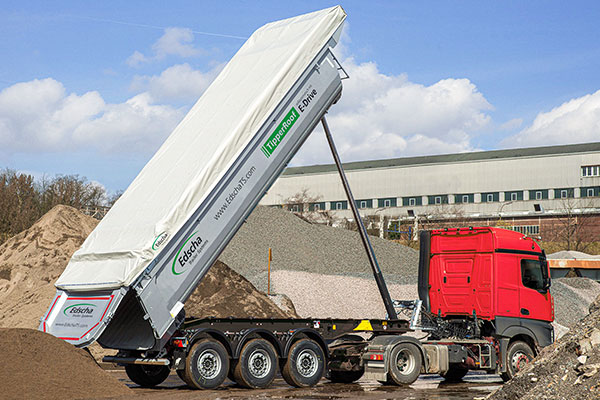Not every roof is the same
But how practicable must a roof be? In hectic everyday life, there is often no time to deal more intensively with the most modern solutions available on the market before purchasing a new vehicle. And so, it often happens that the expensive dump truck is equipped with a roof system that does not satisfy the needs of the buyerafter a short time. This applies in particular to the rapid unloading of bulk goods or, for example, asphalt. The perfect roof therefore requires a little quality awareness and - last but not least - some physics.
Whenever the "negative pressure" comes during dumping
As a rule, the roof of dump trucks always rests directly on the edge of the dump body. This also applies to powered systems, such as electric roller tarpaulins with opening to the side or electric lashing systems with opening to the front. Because the time factor plays an important role when tipping on the construction site, the transported goods are sometimes unloaded without opening the tarpaulin. The problem is that if the load slips out as a "block" during tipping, a strong negative pressure is created in the dump body, which contracts the roof and - in the event of a lack of pressure compensation - can literally destroy it.

Development of strong forces by suction
From a physical point of view, the negative pressure generated in the dump body creates a suction effect similar to pulling up a syringe or sucking out a beverage package with a straw. The undesirable effect here, however, is used positively in other areas. For example, in the form of a suction pad for transporting smooth flat objects or also for brake boosters in passenger cars or light trucks.
A little distance ensures safe pressure equalisation
But how do you solve the problem of the missing pressure compensation by a completely covered tipper body? Edscha Trailer Systems shows you how. With the Edscha TS TipperRoof system, the tarpaulin does not lie directly against the edge of the trough compared to other tarpaulins. The tarpaulin is kept at a distance at all times by a rolling rail system. In addition, the robust running rail is mounted along the entire length at a distance of approx. 1 cm. This ensures the necessary pressure compensation at all times without endangering the sealing of the tipper body. When using an Edscha TS TipperRoof system, dumping with the tarpaulin closed is not only quick and safe, it also saves time and money.






